by Winding Pathways | Mar 7, 2019 | (Sub)Urban Homesteading, Garden/Yard, Trees
Catalog Dreaming
While subzero cold enveloped Winding Pathways we discovered delightful seed and nursery catalogs in our mailbox. Leafing through their photos of rosy ripe tomatoes, peaches, and sweet corn made us dream of warm days as the frigid wind whistled around the house. Catalogs also made us think of our upcoming cherry tree crop.
We love our cherry trees and are happy to have two types growing at Winding Pathways. Most are the wild native Black Cherry, a member of the Rose family and common throughout the Eastern half of the United States.
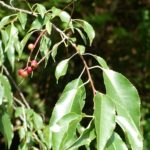
Black cherry juice was mixed with brandy or rum to make “Cherry Bounce.”
Early pioneers sometimes called this tree the Cherry Bear because bruins would walk for miles to feast on its juicy fruit. Bear cubs learned how to climb trees by following their mother up the trunk to reach ripe fruit.
Birds love wild cherries. They’ve helped spread this tree far and wide by feasting on a cherry dinner here and then flying there to poop out the seeds. In many areas, the American Black cherry is almost an invasive species, but one with many attributes.
Thomas Jefferson’s Cherry Tree Wood
People today rarely bother eating the bitter small fruits, but pioneers made Cherry Bounce by mixing the juice with brandy or rum to make a bitter, but flavorful, cordial. Most people today enjoy this tree for its beautiful cabinet wood. When newly cut it is goldish in color, often with an intricate grain pattern. The wood darkens with age. Visitors to Thomas Jefferson’s home, Monticello, Charlottesville, Virginia, often wonder why our third president loved such dark paneling. They don’t realize that when he lived there the newly installed wood glowed with cherry’s warm texture. Two centuries of aging have darkened it.
In our mail recently came the newsletter of the National Arbor Day Foundation with an amazing story about today’s popular Bing Cherry. That’s the delicious fruit often sold in grocery stores to be eaten fresh. In 1847 Henderson Lewelling, of Salem, Iowa, loaded his eight children, pregnant wife, and 700 of his prized cherry tree shoots packed in dirt-filled boxes, into wagons for the long trek to Oregon. They endured freezing temperatures, scurvy, and dysentery but made it and established the Pacific Northwest’s cherry industry.
Two Types
Today, two types of domestic cherry are readily eaten by people. They are distinct from the American Black Cherry and are native to Europe and Asia. One type is called Sweet Cherries with the Bing variety best known. They are delicious when eaten fresh. Sweet cherries thrive in California, Oregon, Washington, Idaho and Montana but don’t like the upper Midwest’s harsh winters. Ironically, Bing cherries got their start in Iowa but don’t grow well in the state today. We don’t have any at Winding Pathways.

Tart cherries make great pies.
We love our sour cherries. They thrive here despite winter’s cold and summer’s inferno, yielding an abundant crop in June. Most commercial sour cherries are grown in Michigan, but they love Iowa. Our favorite variety is the Dwarf North Star. It resists bugs and diseases, and even the deer leave it alone. In some years our cherry crop is almost sweet enough to eat fresh. We love them best blended with mulberries in a pie or mixed into oatmeal. A handy cherry pitter removes some of the tedium of evicting the big seed from each fruit.
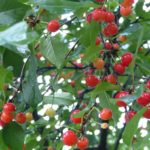
Tart cherries come ripe in June.
Planting a sour cherry in the yard yields delicious fruit for a family to enjoy. Dwarf varieties can be bought from many nurseries. They like full sun and don’t take much space. In contrast, plant an American Black Cherry and eventually, it will produce fruit savored by birds. The tree needs plenty of space. It can grow to 100 feet tall and likes full sun.
Two Great Sources to Learn About Trees

Elegant lodging awaits at the Lied Lodge.
The Arbor Day Foundation, arborday.org has a wealth of information about trees and sells dozens of species at low cost. A few years ago, we enjoyed a delightful visit to Arbor Day Farm in Nebraska City, Nebraska. We overnighted in the Lied Lodge on the property and wandered trails while enjoying tree lure. Adjacent is the home of J. Sterling Morton, Arbor Days founder.
A wonderful old book on tree natural history is a two-volume series called A NATURAL HISTORY OF TREES OF (Eastern or Western) NORTH AMERICA. If you find one at a used book store…….buy it!
ARBOR DAY
Most northern states honor Arbor Day on the Fourth Friday of April each year, but many southern states celebrate it at seasons more appropriate for planting in their climate. Arbor Day dates for all states are listed on this link.
by Winding Pathways | Dec 16, 2014 | Nature, Travel/Columns, Trees/Shrubs
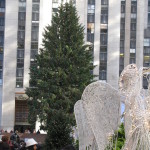
Rockefeller Center is the site of an amazing Christmas Tree that overlooks the skating rink in NYC.
Although increasing numbers of Americans are opting for an artificial Christmas tree, millions enjoy bringing a real tree into their homes for the festive season. As the fashions wax and wane, we see an upsurge in families eagerly venturing out to tree farms to select and cut a real tree. Many species of evergreens are used for Christmas trees but the following species are by far the most common:
EASTERN WHITE PINE: This is the great pine of New England and the upper Lake States that was logged to near oblivion in the late 1800s. It can grow to over 200 feet tall. Thankfully many survived and today the white pines are often used for Christmas Trees in the East. The natural range of the Eastern White Pine is from Southern Canada down to the Mid-Atlantic states and west to about Iowa. It has been widely planted outside its native range and a similar species, the Western White Pine, lives in northern Idaho and nearby Montana and Washington. White pines grow relatively rapidly and have five long soft needles in a bunch.
SCOTS (or Scotch) PINE: This fast growing but usually short lived tree has become increasingly popular as a Christmas tree. They are usually cut when only five or six feet tall, making them ideal for smaller houses and apartments. The species is native to Europe and is the most widespread pine in the world. It has several subspecies. Scots pine has two short twisted and somewhat stiff needles per bundle. On large trees the upper trunk bark is sometimes bright orange.
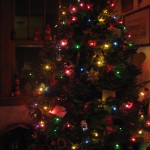
The soft glow of lights on a cold winter’s night warms our hearts.
BALSAM AND FRASER FIRS: This traditional Eastern tree is native to the cool moist north woods. Widespread in upper New England and Eastern Canada its range extends south along the Appalachian Mountains and west to Iowa. One of the slower growing conifers it has the wonderful evergreen fragrance that many people associate with Christmas. A similar tree, called the Fraser Fir, looks almost the same but the underside of its needles is silvery. It is native to the southern Appalachians. Both the Balsam and Fraser Firs have very short needles. These are by far favored Christmas Trees in the North East and along the East Coast.
OTHERS: Ponderosa pines and Douglas Firs are native to many western states and are often used for Christmas trees. A smattering of other pine, spruce, and fir species are also occasionally used.
In the East most people purchase a tree, but out west it’s more common for a family to make an outing to cut a wild tree. Occasionally, a family will bring a cedar, arbor vitae, or even a dried tumbleweed home to decorate as a Christmas “tree”.
by Winding Pathways | Dec 13, 2018 | Garden/Yard, Pests
Lots of boxelder bugs are traipsing through homes this winter to the consternation of human occupants. We reluctantly share our home with a few during cold months.
This amazingly common and crafty insect is a true bug named for common boxelder tree. You don’t have to have boxelder trees nearby to “enjoy” visits by the bug. Maples and ash trees of several species make suitable hosts. Since these trees are everywhere in suburbia it’s no wonder boxelder bugs pester so many people. The insect makes its living feeding on tree seeds and sap yet poses no threat to its host. Unlike the pests of many other trees, boxelder bugs don’t kill trees.
Come fall box elder bugs prepare for cold weather by tucking themselves into bark crevices to patiently wait out the cold. However, they would rather be warm. If a house is nearby, they seem to sense that soon the furnace will be going and indoors is the best place to overwinter.
How Boxelder Bugs Get In
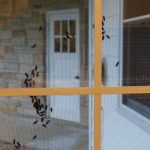
All this winter box elder bugs have gathered on warm sunny sides of homes.
Although they are fairly large insects boxelder bugs can crawl through tiny cracks and holes. Often, they swarm in the sun on the exterior of a house and some manage to find their way inside. Winter is spent idly exploring light fixtures, furniture, and walls.
They are not really a serious pest. Pesky might be a better way to describe them. Boxelder bugs neither bite nor sting. They do sometimes crawl on people and pets. Perhaps their most disagreeable characteristics are pooping and emitting a disagreeable odor if they are crushed. It’s this bad odor that protects them from predators. Hardly anything will eat a boxelder bug.
Getting Rid of Boxelder Bugs in Your Home
Want to rid the house of boxelder bugs? The best defense is a caulking gun. Late each summer seal up cracks that allow them to squeeze into the house. Look for cracks and holes around window and door frames and around wires and pipes leading into the home. Bugs discovered wandering around inside can be vacuumed up, and a shop vac can suck up hundreds sunning on the exterior. Dump them in soapy water and they’ll quickly drown. A hose can also knock them off an exterior wall. Insecticides kill them but perhaps create more problems than they solve. Some people report that spraying them with soapy water also kills them.
We’ve had some success at Winding Pathways in reducing the number of bugs we pick off walls and windows in the winter. We used to bring in a week’s worth of firewood and stack it near the woodstove. For years we didn’t realize boxelder bugs were hiding in the wood. Once they warmed up the insects set out exploring the house. Now we leave wood outside and only bring in a few pieces that go directly into the stove. It’s reduced, but not eliminated, the number of boxelder bugs inside.
Boxelder bugs aren’t harmful, but they are pesky and goofy. Caulking a home’s cracks can encourage them to winter outdoors in trees, rather than in homes. One speaker on Science Fridays quipped, “Boxelder bugs have nowhere to go and all day to get there.”
by Winding Pathways | Mar 14, 2017 | Nature, Pests

All this winter box elder bugs have gathered on warm sunny sides of homes.
Lots of box elder bugs are traipsing through homes this winter to the consternation of human occupants.
This amazingly common and crafty insect is a true bug named for common box elder trees. You don’t have to have box elder trees nearby to “enjoy” visits by the bug. Maple and ash trees of several species make a suitable hosts. Since these trees are everywhere in suburbia it’s no wonder box elder bugs pester so many people. Box elder bugs make their living feeding on tree seeds and sap but they don’t pose a threat to their host. Unlike the pests of many other trees box elder bugs don’t kill trees.
Come fall, box elder bugs prepare for cold weather by tucking themselves into bark crevices to patiently wait out the cold. However, they would rather be warm and if a house is nearby they seem to sense that soon the furnace will be going and indoors is the best place to overwinter,.
Although they are fairly large insects box elder bugs can crawl through tiny cracks and holes. Often they swarm in the sun on the exterior of a house and some manage to find their way inside. Winter is spent idly exploring light fixtures, furniture, and walls.
They are not really a serious pest. Pesky might be a better way to describe them. Box elder bugs neither bite nor sting. They do sometimes crawl on people and pets. Perhaps their most disagreeable characteristics are pooping and emitting a disagreeable odor if they are crushed. It’s this bad odor that protects them from predators. Hardly anything will eat a box elder bug.
Want to rid the house of box elder bugs? The best defense is a caulking gun. Late each summer seal up cracks that allow them to squeeze into the house. Any found wandering around inside can be vacuumed up, and a shop vac can suck up hundreds sunning on the exterior. Dump them in soapy water and they’ll quickly drown. A hose can also knock them off an exterior wall. Insecticides kill them but perhaps insecticides create more problems than they solve. Some people report that spraying box elder bugs with soapy water also kills them.
Box elder bugs aren’t harmful, but they are pesky and goofy. Caulking up home cracks can encourage them to winter outdoors in trees, rather than inside with you.
#
by Winding Pathways | Jan 25, 2024 | Nature, Reflections/Profiles
Lots to Experience in January
(reworked from the Patterson’s “Iowa’s Wild Side” column
originally in the Cedar Rapids Gazette)
Winter in Iowa is erratic. Mild. January thaws. Grey, damp, and achy mornings. Frigid. Blustery. Sunny, sparkling days when all is right. We have it all. Here are ways we a find joy in January.
Some people escape to warmer regions. Most of us hang tough and grumble. At Winding Pathways, we’ve found that simple observations can enliven and deepen our appreciation for the change of seasons.
Sit Still
Bundled up in his Carharts and sitting quietly downwind at dusk, Rich notices deer begin to move. Stars and planets glow. Five geese honk and wing across the waxing moon. A photographer’s dream. An owl’s call fills the stillness left behind.
Wildlife freeze as the great horned owl’s ghostly shape floats silently to a branch near our home. Puffed to twice its size, a buffer against the cold, it waits. Several long minutes pass. Then, a rabbit cautiously emerges from the prairie stubble. An opossum noses hungrily at the compost heap. A startled mouse scurries across an open space. With talons extended and yellow eyes gleaming, the owl drops. After a brief scuffle, only bits of fur remain.
-
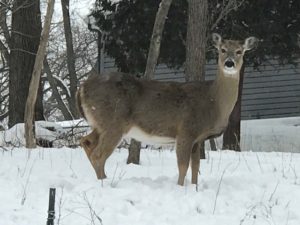
-
Inquisitive doe.
-
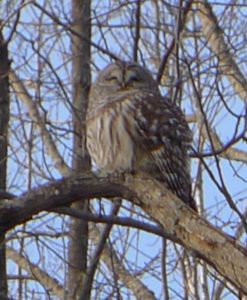
-
Waiting
-
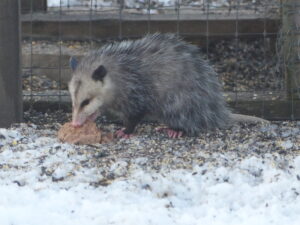
-
Possums’ feet help it climb.
Observe When You Drive
Another way we find Joy in January is by taking drives. Across a frosty Iowa road, we slow as four deer race across a field, leap a barbed wire fence, and dash to safety beyond busy Highway 30. We speculate what startled them. A short time later we observe a face-off between a grazing cow and a foraging hawk. Neck stretched out, nose to the wind, the cow eyes the hovering hawk.
From the comfort of our home, we watch birds. Siskins, when the weather is cold, Carolina wrens when winters are mild, hang around the feeder and shrubs loaded with berries. A red-headed woodpecker pecks at suet. It rattles noisily and jabs its lance-like bill at the less aggressive birds. Its strong bill is great for hammering insects out of frozen trees and pounding holes in ice-encased water baths.
January Ice
Black ice is another winter phenomenon. While not fun to drive on it is intriguing on rivers, ponds, and lakes. One Kansas winter an Arctic airmass plunged into the heartland and gave us a chance to peer into the dark depths below. A snapping turtle slowly swam through the thick water. Ice skaters reveled in the unusual event.
Nowadays we enjoy Arctic air from the inside. A small pool is just outside our window near the feeders. Sometimes, when temperatures drop quickly, and black ice forms we can see “through the looking glass” so to speak. A small aerator keeps a circle of water open. Small birds hop to the edge and drink. The overwintering goldfish appreciate the extra O2.
And we enjoy hot chocolate during January’s dormant month.










